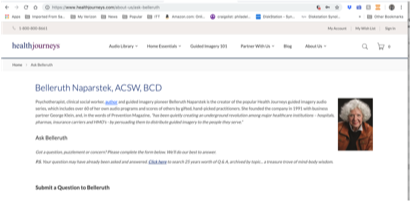Multi-sensory Guided Imagery
The Theory
According to Belleruth Naparstek, Guided imagery is intentional, directed daydreaming-blending one’s imagination with words and phrases that evoke sensory fantasy and memory. Guided imagery creates a deeply receptive mind, body, psyche and spirit state during which change becomes possible. For most of us, imagery is an accessible form of meditation yielding immediate empirically proven benefits including a wide variety of physical and psychological outcomes.
Below is an interview clip of Guided Imagery with Belleruth Naparstek:
The ones of interest to this population include:
*Reduction of anxiety and depression
*Decrease in blood pressure
*Strengthening of immune function
*Reduction of pain
*Reduction of bingeing and purging in those with bulimia
*Improvement in attention and concentration
Imagery is effective because it basically bypasses rational thought and logical assumptions - delivering healing messages directly to the hypervigilant primitive brain. Once received, imagery disperses gentle reminders of health, strength, meaning and hope that affect unconscious assumptions and self-defeating concepts.Because it is processed through the right brain’s primitive, sensory, and emotion-based channels, it is an ideal intervention for post-traumatic stress.
Imagery works on the right-brain the home of feeling, sensing, and perceiving, rather than the thinking, judging, analyzing and deciding functions of the left brain. Since it does not depend on the brain’s logical and analytic centers, it circumvents psychological resistance, fear, hopelessness, worry, and doubt, and goes directly to attitude and self-esteem, without interference from the rather obstinate, literal mind.
Brain development studies have shown that a traumatized brain is impaired in its ability to focus on language or verbal content. Instead, it tends to focus on...processing nonverbal danger cues—body movements, facial expressions, and tone of voice—as it searches for information about danger and threat. The primitive brain in effect co-opts cognition and behavior in the service of safety and survival. Unfortunately this causes some temporary loss in ability to think abstractly, process language, and attend to ideas or word meanings. These functions are higher cortical functions- gray matter issues- which can only be attended to once the primitive brain is sufficiently calmed. It seems clear that interventions that rely on cognitive, problem-solving activities do not, and more importantly, cannot have much impact on these clients or their terror-driven behavior.
With the advancement of technology, neuroscience has shown us that traumatic changes appear in Broca’s area of the brain, where personal experience gets translated into language. It appears that survivors can see, hear, smell, taste and feel parts of the traumatic event, yet struggle unsuccessfully to translate these sensory elements into language. In addition to this “speechless terror”, some long-term trauma survivors experience an additional obstacle in their analytic ability. Due to persistently high elevation of stress hormones, causing a reduction in the size of the hippocampus, survivors are often less able to put things in context and/or make critical distinctions about what is and what is not threatening in the present. Without this necessary discernment, survivors become more and more impulsive and less and less inhibited. In effect, what survivors are left with is a constantly hyperaroused autonomic nervous system; an inability to distinguish past from present threat – necessarily producing a state of constant hypervigalence; a speechless terror accompanied by painful and traumatic sensory and body memories; and a marked inability to access any their own cognitive resources.
Quite a predicament.
What should be resoundingly apparent to the reader is that talking “about trauma”- which requires participation from the language/ logic portion of the left brain- is inadequate, oftentimes triggering, and very likely re-traumatizing to the client. A better option for therapists would be to target the client’s highly sensitive, hyperacute right hemisphere with its overfunctioning visual, sensory, and emotional channels. By accessing the limbic system and the right hemisphere of the brain, survivors are able to process the images, body sensations and feelings, attach some sort of meaning to them, and eventually move toward a more helpful and adaptive resolution of the traumatic material.
Recent RCT studies of military sexual trauma and combat trauma survivors show that Imagery offers a viable solution. Using a calming tone of voice, music and symbolic representations of safety, imagery quiets the hypervigilant primitive brain, creating an environment where the higher brain can once again function in the service of the survivor.
Naparstek posits that guided imagery provides a cushion of evocative, multisensory protective images and built-in emotional safety. Appealing memories and lush fantasies require little energy or discipline to evoke. They provide distraction from pain; carry clients beyond worry, fear and anguish she goes on to report that guided imagery has the ability to avoid the direct traps of language and literalism. A powerful healing tool, that provides a kinder, gentler and more effective route to tending to wounds of the inner self. Naparstek explains that the imaginary world developed through imagery is a generous place where clients can gain distance by locking pain away in a safe, floating it away on the wind, or erasing it from an imaginary blackboard. In this world, clients can summon protection and support from magical allies, remembered friends, favorite animals, powerful ancestors, guardian angels and other divine helpers. They can create as many layers of distance between the traumatic event and themselves as needed. All the while surrounding themselves with loving, powerful protectors.
The Tools:
How to make a Guided Meditation with Music
Belleruth Naparstek's Books:
Staying Well With Guided Imagery
Invisible Heroes: Survivors of Trauma and How They Heal
Belleruth Naparstek's Website:

